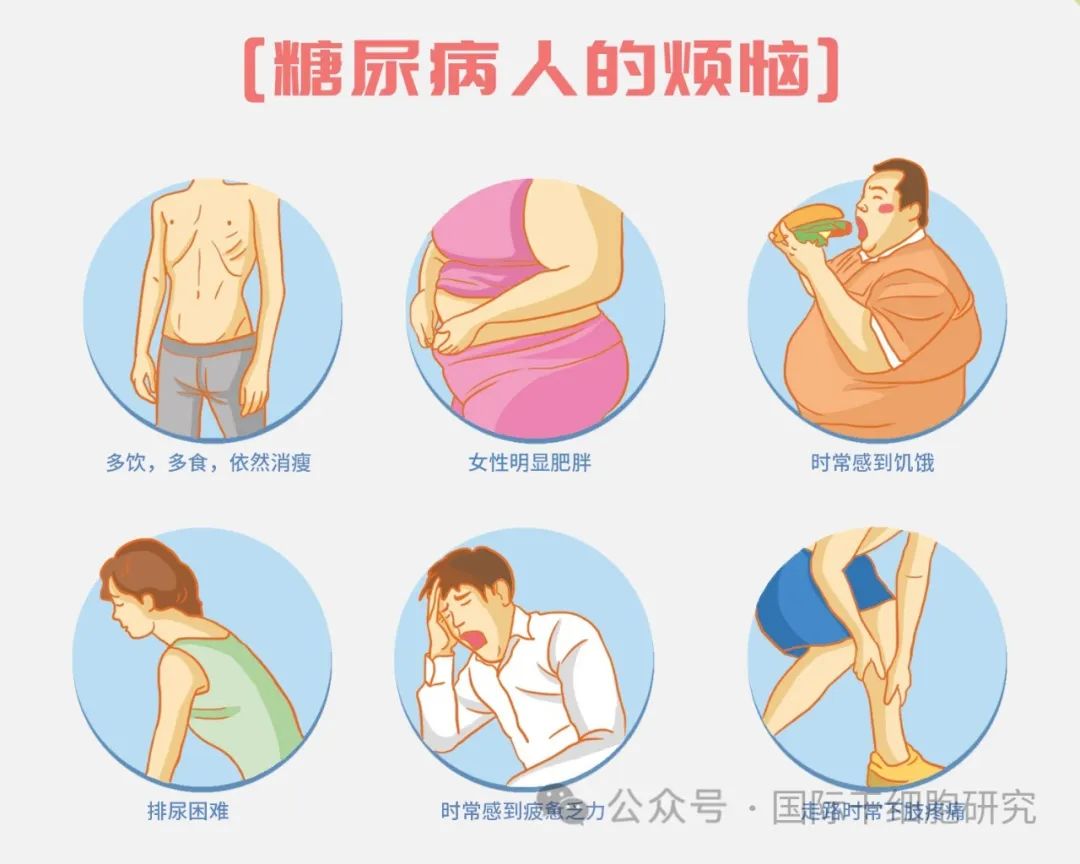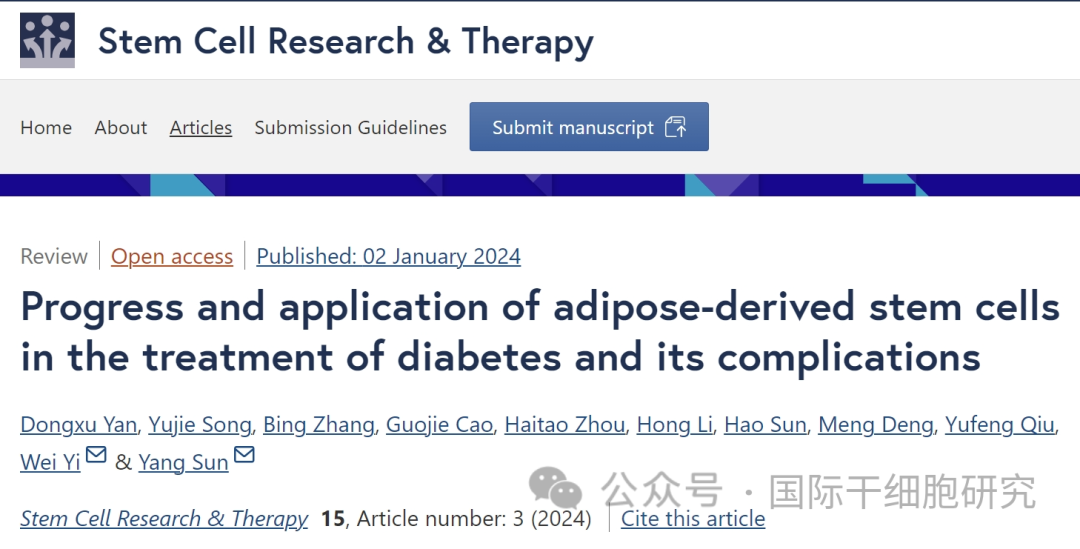
Source: International Stem Cell Research
In June 2023, according to the "Xinhua" news, the clinical research record of "human FGF21, GLP-1 double factor high expression of autologous adipose mesenchymal stem cells (MSC) in the treatment of type 2 diabetes" declared by Ruijin Hospital Affiliated to Shanghai Jiao Tong University School of Medicine was approved.
Starting from the multidimensional aspects of diabetes treatment, the researchers used gene technology to fuse FGF21 (hepato-secreted cytokines), GLP-1 (intestinal polypeptide) and fat MSC to develop "CAR-Like mesenchymal stem cells", which were given new targets and functions, including regulation of glucose and lipid metabolism abnormalities; It can also use homing characteristics to play a targeted therapeutic role, so as to protect islet beta cells, inhibit the occurrence of diabetes complications, and finally achieve the dual role of regulating metabolic disorders in type 2 diabetes patients and repairing tissues and organs, which can be described as "killing two birds with one stone"! The technology, which has now been granted an international patent, also provides a new track for the treatment of diabetes, namely "the treatment of diabetes through fat stem cells".

PART1 Diabetes

Diabetes mellitus (DM) is a severe chronic metabolic disease with a high prevalence worldwide, characterized by absolute or relative insulin deficiency or insulin resistance.
The existing treatment methods for diabetes, such as oral hypoglycemic drugs, insulin injection, islet cell transplantation, etc., all have certain limitations. If the patient's diet is not properly controlled or the medication compliance is poor, it may also lead to the continued progression of the disease, and even a variety of complications, such as cardiovascular disease, neuropathy (such as diabetic foot), retinopathy, kidney disease, and so on. Therefore, it is necessary to explore alternative treatments for diabetes and maintain its therapeutic effect.
In recent years, with the continuous development of regenerative medicine, stem cells with self-renewal, differentiation potential and immunity regulation have brought new hope to diabetic patients, especially adipose-derived stem cells (ADscs) with wider sources and less trauma, which have become the leader among them.
PART2 Traditional treatment of diabetes and its limitations

1、Drug therapy
At present, the traditional treatment of diabetes mainly relies on continuous use of hypoglycemic drugs, or the use of insulin to control blood sugar.
However, these methods also have certain limitations. For example, long-term medication may bring certain risks, and it is necessary to constantly monitor the side effects of hypoglycemic drugs, which will seriously affect the quality of life of patients. At the same time to the family bearing economic burden; In addition, drug treatment can not effectively prevent the occurrence of related complications, which is also a problem that cannot be ignored.
2、Whole pancreas and islet cell transplantation
At present, the methods of replacing beta cells that have been used in the clinic mainly include whole pancreas and islet cell transplantation. However, this method is not suitable for most patients due to many limitations such as lack of islet donors, organ and cell failure after transplantation, and lifelong immunosuppressive therapy after transplantation.
PART3 Advantages of adipose stem cells in the treatment of diabetes
Adipose-derived stem cells (ADscs) have the following advantages over other stem cells:
1、Widely sourced
ADSC is mainly taken from the patient's own fat rich location, such as umbilical circumference, buttocks and so on.
2、Easy access, less traumatic
Stem cells are extracted through liposuction or minimally invasive small incision, which is a minimally invasive surgical method, with little pain, fast recovery and no obvious postoperative scar. Here, taking Japan as an example, briefly introduce the treatment process of ADSC stem cells:
The first step is preoperative examination: Before treatment, the doctor will confirm the patient's previous medical history, current medical history, personal history, etc., and explain the effect, safety, and risk of stem cell therapy to the patient; Those who meet the treatment standards need to carry out standardized examinations (such as ten viral examinations, etc.), and those who pass the examination results can carry out fat collection.
The second step is to collect fat tissue: After local anesthesia, the doctor will take fat granules in the fat accumulation area such as the umbilical circumference (or buttocks) of the patient through liposuction or minimally invasive small incision.
The third step is blood collection: on the same day that the fat tissue is collected, the doctor will also collect a small amount of blood from the patient for stem cell culture.
Fourth step, culture of stem cells: After the adipose tissue collection is completed, cell culture is generally carried out for 4 to 6 weeks. Specific training time, there are some individual differences.
The fifth step, stem cell transfusion: depending on the patient's condition, intravenous infusion, local injection, subarachnoid injection and other methods are used to transfuse stem cells. Generally, the infusion needs to be about 40 to 60 minutes, and the specific time depends on the different way of transfusion, and there are certain individual differences.
3、The treatment of diabetes is very effective
ADSC has a wide range of regenerative and differentiation capabilities, and can inhibit inflammatory response, reduce tissue damage and apoptosis, and regulate immune system and metabolic functions. At the same time, it can improve insulin sensitivity and enhance insulin secretion through various ways, so as to alleviate diabetes and its complications.
PART4 Diabetes classification
According to the different causes of diabetes, can be divided into type 1 diabetes, type 2 diabetes, gestational diabetes, other types of diabetes four types. Here is a brief introduction to the causes of type 1 and type 2 diabetes that are more common in clinic.
1、T1DM
Due to an autoimmune response, helper T cell 1 (Th1) attacks pancreatic beta cells, resulting in the loss of insulin-producing cells (IPC). Because pancreatic beta cells are the only producers of insulin in the body, their damage and extinction may lead to the disappearance of insulin secretion, and eventually cause the occurrence of type 1 diabetes.
2、T2DM
T2DM accounts for 85% to 95% of all diabetic patients, and insulin resistance and pancreatic β cell secretion dysfunction play a crucial role in the occurrence and development of T2DM. Some patients can also cause adipose tissue inflammation due to excessive nutrition, which affects insulin sensitivity and beta cell function, resulting in problems in multiple tissues and organs.
PART5 How Can Fat Stem Cells treat Diabetes?

1、Adipose stem cells (ADSC) in the treatment of type 1 diabetes restore the function of residual islets in the body:
ADSC not only serves as a source of insulin-producing cells (IPC), but also supports the function of residual islets in diabetic patients. After ADSC transplantation into patients, it can release a variety of cytokines [such as vascular endothelial growth factor (VEGF), tissue inhibitor of metalloproteinase 1 (TIMP-1), interferon-induced protein 10, etc.], thereby organizing the apoptosis of ADSC cells and promoting the proliferation of β cells.
Maintain islet graft function in vivo or in vitro:
Adipose-derived stem cells (ADscs) can be used to pretreat islet grafts in vitro to enhance the viability of islet grafts. On the one hand, ADSC promotes the generation of new vascular networks in co-transplanted islets by secreting various angiogenic factors (such as hepatocyte growth factor VEGF, etc.), significantly increasing the vascularization of transplanted islets. On the other hand, it can also inhibit the production of pro-inflammatory cytokines [such as TNF-α (tumor necrosis factor α), IFN-γ (gamma interferon), etc.), and inhibit the infiltration of inflammatory cells, thus extending the survival time of co-transplanted islets, and ultimately achieving the purpose of treating type 1 diabetes.
2、Adipose stem cells (ADSC) for type 2 diabetes
Promote insulin production:
Studies have shown that ADscs promote insulin production in two main ways. First, ADSC can promote the recovery of remaining islet function by reducing caspase-3 activity. Secondly, ADSC can also promote islet vascularization by secreting hepatocyte growth factor (HGF), insulin-like growth factor 1, VEGF, etc., thus helping to increase the number of islet beta cells.
Improve insulin resistance:
Studies have shown that ADSC transplantation can restore the number of glucose transporter 4, insulin receptor on the cell membrane of skeletal muscle, liver, and adipose tissue, and increase the phosphorylation of insulin receptor substrate 1 in the high-fat diet /STZ. This can help relieve the state of high blood sugar and insulin resistance. However, there are few clinical trials on ADSC for T2DM.
3、What other stem cells can treat diabetes?
UC-MSCs:
Compared with other stem cells, UC-MSCs have greater differentiation potential. Studies have shown that after transfusing UC-MSCs, the number of regulatory T (Treg) cells in patients increases, and the insulin requirement is slightly reduced, so as to achieve the therapeutic purpose. Moreover, such stem cells are derived from allogeneic umbilical cord tissue, which will not cause trauma to the patient itself, and such stem cells are mainly used in China at present.
BM-MSCs:
Studies have shown that after bone marrow mesenchymal stem cell therapy, the insulin requirement of patients is reduced, insulin sensitivity is increased, and β cell function is improved, so as to achieve the therapeutic purpose. However, BM-MSCs need to be obtained invasively through the ilium or femur, which is relatively painful for patients, and the number of cells extracted at a single time is small.
Placenta derived stem cells:
Studies have shown that the use of such stem cells to treat type 2 diabetes can reduce insulin requirements by more than 50%, and kidney and heart function can be improved to a certain extent. However, there are some ethical problems with these stem cells, which limit their clinical application. In summary, the International stem cell Editor reminds us that different types of stem cells have certain differences in their characteristics, extraction methods and therapeutic effects, which need to be selected according to the patient's situation and according to the doctor's advice.
PART6 Small series message
Although the treatment of diabetes with adipose stem cells is still in its early stages, more and more studies have proven its safety and effectiveness, bringing a new dawn to diabetes patients! Our neighbor Japan, for example, has approved the use of autologous adipose mesenchymal stem cells. With the continuous development of China's stem cell field, Xiaobian also expects that more sugar friends will benefit from it in the future!
PART7 Reference material
[1]Yan D,et al.Progress and application of adipose-derived stem cells in the treatment of diabetes and its complications. Stem Cell Res Ther. 2024 Jan 2;15(1):3.
https://stemcellres.biomedcentral.com/articles/10.1186/s13287-023-03620-0
[2]http://bj.news.cn/20230607/be8aca9e7f4f43829797fd0e3fce4e5d/c.html